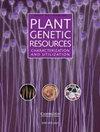安吉尔蜜瓜遗传多样性的研究印度的科雷亚种群
IF 0.7
4区 生物学
Q3 PLANT SCIENCES
Plant Genetic Resources: Characterization and Utilization
Pub Date : 2023-07-24
DOI:10.1017/s1479262123000485
引用次数: 0
摘要
牛耳是一种重要的橡果科亚热带水果作物,广泛分布于东南亚。对当地社区来说,其果实和叶子的营养成分提供了巨大的经济和社会可能性。然而,由于其未被充分利用的状况以及其自然栖息地受到的人为威胁,必须执行具体的培育和保护战略。为了充分掌握这种适应性强的果树对人类健康和环境福祉的能力,有必要对其遗传多样性进行表征。本研究利用形态(13个数量性状)、生化(9个性状)和分子(10个SRAP引物)鉴定了来自印度两个农业生态区的24个bael基因型。果实和果肉重量分别为79.0 ~ 1478.8 g和15.0 ~ 894.3 g,平均值分别为448.67和233.3 g。果实、果肉和种子重量(g)、果实长度(cm)和宽度(cm)、单树果数、每果种子数、壳重(g)和壳厚(mm)等性状差异极显著。果肉中酚(11.65 ~ 24.38 mg CE/g fw)和黄酮类化合物(12.32 ~ 74.63 mg CE/g fw)含量高,具有显著的抗氧化潜力。几个形态和生化性状发现有显著的正相关。主成分分析表明,前5个分量对总变异贡献率为96.76%。分层聚类分析将种群划分为两个不同的聚类,利用SRAP标记进行分子方差分析(AMOVA),发现70%的总标记变异是由种群间变异引起的,30%是由种群内变异引起的。本文章由计算机程序翻译,如有差异,请以英文原文为准。
Exploring the genetic diversity of Aegle marmelos (L.) Correa populations in India
Bael is an important sub-tropical fruit crop in family Rutaceae that is widely distributed throughout South-East Asia. For local communities, the nutritious composition of its fruits and leaves offers tremendous economic and social possibilities to exploit. However, its underutilized status, as well as man-made threats to its natural habitat, make it imperative to implement concrete strategies for its cultivation and conservation. To fully grasp the ability of this adaptable fruit tree for human health and environmental well-being, it is necessary to characterize the genetic diversity. The goal of this study was to use morphological (13 quantitative traits), biochemical (9 attributes) and molecular (10 SRAP primers) characterization to evaluate 24 bael genotypes from two agroecological zones of India. Fruit and pulp weight ranged from 79.0– to 1478.8 g and 15.0– to 894.3 g with mean values of 448.67 and 233.3 g, respectively. Traits such as fruit, pulp, and seed weight (g), fruit length (cm) and width (cm), number of fruits per tree, number of seeds per fruit, shell weight (g) and shell thickness (mm) recorded highly significant differences. High phenol (11.65–24.38 mg GAE/g fw) and flavonoid (12.32–74.63 mg CE/g fw) content was observed in fruit pulp indicating significant antioxidant potential of this fruit. Several morphological and biochemical characters were found to have significant positive correlations. Principal component analysis revealed that first five components contributed 96.76% to total variation. Hierarchical cluster analysis separated the populations into two distinct clusters, while analysis of molecular variance (AMOVA) using SRAP markers revealed that 70% of the total marker variation was due to interpopulation variance, while 30% was attributed to intrapopulation.
求助全文
通过发布文献求助,成功后即可免费获取论文全文。
去求助
来源期刊

Plant Genetic Resources: Characterization and Utilization
Agricultural and Biological Sciences-Agronomy and Crop Science
CiteScore
2.80
自引率
0.00%
发文量
29
审稿时长
>12 weeks
期刊介绍:
Plant Genetic Resources is an international journal which provides a forum for describing the application of novel genomic technologies, as well as their integration with established techniques, towards the understanding of the genetic variation captured in both in situ and ex situ collections of crop and non-crop plants; and for the airing of wider issues relevant to plant germplasm conservation and utilisation. We particularly welcome multi-disciplinary approaches that incorporate both a technical and a socio-economic focus. Technical aspects can cover developments in technologies of potential or demonstrated relevance to the analysis of variation and diversity at the phenotypic and genotypic levels.
 求助内容:
求助内容: 应助结果提醒方式:
应助结果提醒方式:


